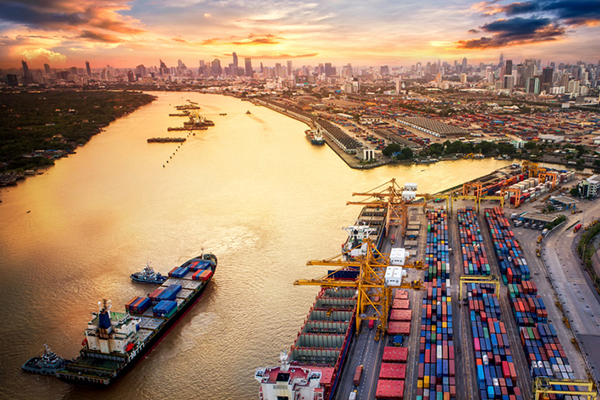 Editor’s Note: Paul Bingham, Director of Transportation Freight Consulting at IHS Markit, always provides our readers with remarkable insights on the state of ocean carrier industry.
Editor’s Note: Paul Bingham, Director of Transportation Freight Consulting at IHS Markit, always provides our readers with remarkable insights on the state of ocean carrier industry.
Supply Chain Management Review (SCMR): Will ocean carriers be able to sustain their rate structures amid a high level of blank sailings and volume declines?
Paul Bingham: The liner industry’s track record of maintaining vessel capacity deployment discipline over the long-term has been poor in the last decade. However they industry proved they could exercise discipline coming out of the Great Recession in 2010 which led to the highest overall rates for any year in the decade. During this recession the container carriers are proactively adjusting capacity week-to-week through blanked sailings (and some vessel lay-ups) to sustain their rate structures in the face of the overall decline in trade volumes.
SCMR: How long will this behavior persist?
Bingham: There remains a fundamental supply/demand imbalance between total vessel fleet capacity and demand, that carriers only partially overcome through blanked sailings, slow steaming and the vessel lay-ups we’re seeing now. Even with those vessels laid up in shipyards for installation of new engine exhaust scrubbers, it will likely take a long time to work off the vessel capacity supply / demand imbalance through vessel retirements and the offsetting pressure from newly-built vessels still being added to the global fleet. The container operators recently have been more restrained in placing additional vessel orders, resulting in a declining backlog in the shipyards’ orderbooks as new vessels are completed.
SCMR: How likely will carriers return to “slow steaming” to reduce costs?
Bingham: Even with bunker fuel relatively inexpensive relative to ISO2020 expectations for low sulfur fuel costs this year, slow steaming is attractive for a key reason other than the direct reduction in fuel costs. That is because slow steaming also helps absorb some of the excess capacity in the global vessel fleet by requiring more total vessel capacity in total to move the same volumes over the same network of routes in a given amount of time. Slow steaming also helps with vessel emissions performance by carriers, a factor important to some customers and to governments still pursuing carbon footprint reductions as part of climate change initiatives.
SCMR: Do you see more construction of “mega-vessels” in the future?
Bingham: There will be construction of additional mega-vessels in the future for deployment for those trades, such as Asia-Europe, where the large volume density makes the economies of scale for those ships compelling. The previous generation of mega-vessels deployed heavily now on the Asia-Europe trade lane will eventually be cascaded into other trades. Most commonly into the transpacific as well as with more pendulum services, the transatlantic trade, as the new largest 20,000-24,000 TEU mega-vessels increase their share of the Asia Europe trade.
SCMR: Will this trend continue?
Bingham: The long-term trend has limits however where there will not be truly ever-larger vessels for decades to come. Just because the marine architects can design vessels and shipyards can build ships much larger than today’s largest mega-ships, ever-larger vessels increasingly run up against economic costs on the land side (diseconomies of scale) that act to limit their financial viability in much greater numbers.
SCMR: Are there any other complications?
Bingham: Yes, and that’s a good question. The land-side operational impacts of loading and unloading the huge volumes of cargo on much-larger vessels along with the inflexibility in terms of the number of ports they can call fully laden slows the trend towards ever-larger mega-vessels. Insurance costs in the event of vessel casualty also are a factor due to the concentration of financial risk for insurers calculating premiums to charge operators of such ultra-large ships.
SCMR: Are there any carriers today that are insolvent or vulnerable to a takeover?
Bingham: The carriers with sovereign ownership or implicit national state support are most likely to survive difficult financial conditions. During the Great Recession of 2009 no global container carrier was liquidated or allowed to fail. That was the consequence of financial sector and national government support for specific carriers, so the precedent in the liner industry is that deep recessionary economic conditions do not necessarily lead to insolvency. Takeovers among the remaining operators are possible although difficult right now because commercial financing with current debt market conditions worldwide is a challenger as well takeovers becoming increasingly difficult over time as fewer and fewer global carriers are left.
SCMR: What about consolidation? Will that trend continue?
Bingham: The slow, decades-long consolidation trend is not likely at its end from a long-term perspective. The attraction of economies of scale operationally and for marketing / branding / administrative perspectives is still there within the liner industry, yet immediate conditions aren’t favorable towards further consolidation in the near-term. There are remaining industry competitiveness concerns expressed by shippers and regulators in some countries that also act as an impedance to further consolidation, where concessions that further combined operations may need to grant regulators act to reduce attractiveness of further consolidation. That factor at least slows progress towards further consolidation. An increasing factor in this regard is the recent growth in nationalistic political concerns in some countries which could prompt some regulators to be more hesitant to approve further consolidation without competitiveness concessions.
SCMR: We’re seeing a steady decline of inbound vessel calls to West Coast ports. What’s driving this carrier trend…and will it continue?
Bingham: The drop in vessel calls has been a result of a number of factors but in 2020 it has been primarily the blanked sailings by carriers trying to sustain shipping rates. Carriers are trying matching deployed capacity to bookings, week to week. Carriers, through their alliances, have been able to hold rates higher than might have been expected given the overall drop in international trade volume with the pandemic-driven recession. This pattern will likely continue in some form going forwards, although blanked sailings at some stage become effectively just reduced services offered on the trades and shipper expectations will adjust to match. If most weekly sailings are blanked on a service long enough, essentially there is little difference from full cancellation of a service combined with an extra loader sailing added to the trade in some weeks. Long-term, West Coast ports face challenges from country source supply shifts that see centroids of production of some goods in Asia, and growth in import demand in Asia move to the south and west. That shift benefits all-water services to the East and Gulf Coasts, through Panama (for vessel service strings of up to about 14,000 TEU in size) or Suez (no limit on containership size, except at US ports.)
SCMR: Do you expect carriers to differentiate their services to meet the unpredictable demand cycles of the pandemic?
Bingham: Operating as part of the alliances it is difficult for any one carrier to differentiate their services fundamentally in terms of ports of call, service speed or service reliability. Individual carriers can attempt to compete on factors under their control that can affect shipper choice such as free time, detention and demurrage charges, operational options such as storage – in – transit, and better integration with information service intermediaries who can help improve visibility for shipments, all helping shippers cope with unpredictable demand cycles.
SCMR: The closure of international borders and quarantines of entire countries is something new. What has been the impact on the ocean cargo sector?
Bingham: Operations of ocean cargo terminals have been little affected, as those were mostly very quickly identified as essential services and where protocols to protect the workforce were adopted rapidly.
SCMR: Can you provide some examples?
Bingham: There has been some loss of productivity in the terminals and with dray trucking and rail connectivity due to the extra precautions that workers must take. On the vessel operations side, inherent social distancing and the duration of ocean voyages is sufficient to protect most vessel crews from virus spread if they don’t go ashore and the harbor pilots or new crew members don’t carry the virus aboard in port.
SCMR: What about the impact on human resources?
Bingham: Apart from the sharp changes in underlying commodity volume demand for ocean shipping, the border closures and quarantines have most affected the mobility of the ocean cargo workforce.
SCMR: Where do you see the biggest impact?
Bingham: Perhaps the largest impact has been on individual vessel crews now suffering much more difficult working conditions when quarantined on vessels without shore leave and much more difficult crew changes. So far, unlike with passenger cruise ships, the number of ocean cargo vessels detained or refused port entry has been very small compared with the number of cargo vessels in operation. Hopefully adopted protocols will allow that to continue, and countries will not shut down ocean cargo terminals or related trucking and rail operations.
SCMR: Finally, what advice do you have for logistics managers who are seeking to mitigate risk during the disruptive era?
Bingham: Better visibility of shipments becomes more important to be able to minimize disruptions as conditions change country-to-country. Comprehensive country risk management information is available for managers to include in monitoring conditions in relevant markets. IHS Markit provides customers with ongoing monitoring of risk events and developments globally, tailored to managers’ needs across the globe.
SCMR: So what next?
Bingham: Going forwards, supply chain managers will benefit from reassessing their supply chain sourcing and distribution networks, including tier suppliers and key network links and nodes. Also an understanding of changing conditions affecting customers is valuable to be able to mitigate against risks from changes in demand. Use of supply chain risk modeling for quantification of risk and decision-support at the country, enterprise and supply chain level can help minimize impacts from the disruptions.
SC
MR


Latest Supply Chain News
- Few executives believe their supply chains can respond quickly to disruptions
- Technology’s role in mending supply chain fragility after recent disruptions
- Tech investments bring revenue increases, survey finds
- Survey reveals strategies for addressing supply chain, logistics labor shortages
- Israel, Ukraine aid package to increase pressure on aerospace and defense supply chains
- More News
Latest Podcast

 Explore
Explore
Business Management News
- Few executives believe their supply chains can respond quickly to disruptions
- Technology’s role in mending supply chain fragility after recent disruptions
- Survey reveals strategies for addressing supply chain, logistics labor shortages
- How CPG brands can deliver on supplier diversity promises
- How S&OP provides the answer to in-demand products
- AI, virtual reality is bringing experiential learning into the modern age
- More Business Management
Latest Business Management Resources

Subscribe

Supply Chain Management Review delivers the best industry content.

Editors’ Picks





